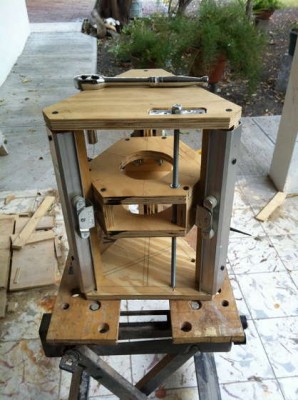
Adjusting the bit height on a router table can be a pain in the butt. Traditionally you needed to get into the cavity under the table top in order to make these adjustments, and it’s hard to make the adjustment and measure the height at the same time. Modern routers now offer the option to adjust height through a hole in the plate that sits in the router table, but this is usually only found on the more expensive models. Rather than buy a new tool [Urant] built his own router lift.
He’s using recycled closet rails to give his rig some smooth operation. These are the rails and runners that let closet doors hang from the top jamb. He saved them when replacing the closet doors in one of his rooms. There’s a triangular gantry which hosts the router, allowing it to move vertically on the three sets of rails. The threaded rod in the foreground of the picture above lets the woodworker adjust bit height by turning the nut at the top. Once mounted in the router table the nut is accessible through a small hole in the table surface.














Ooohhhhh!! ROUTER… I thought… you meant… you know, like… a router.
Sorry. Got it.
Moving on.
looks fairly nice and well designed. good job!
Wicked good idea, and I need one. A friend gave me a garage door opener, I might be able to use it.
He basically built an upside-down Z-carriage for his router table.
Nice job and use of reclaimed materials.
I guess I’m not understanding how he managed to eliminate axial movement of the router. Most closet door hangers aren’t very stiff and it would seem like the side opposite the lead screw (threaded rod) would tend to sag under the weight of the router. Add to that any downward forces during a cutting operation and the effect could be amplified.
On the other hand, I did once hear of someone giving a router a bad review online because there was two thousandths of an inch of endplay in the motor bearings. How anyone would be able to even see such a small difference in wood baffles me.
I guess if it works to his liking, that’s great.
oh, I though the meant the drag of zero-ing the z-asis on a cnc router. But this is about the hand/closet operated device. Meh.
Easier and probably better as well: http://www.instructables.com/id/Ultra-cheap-router-lift/
@Signal – It is speculation on my part of course, but it seems like axial movement would be minimized by the tension of the wheels against the track. I would assume three acme threaded rods tied together with a belt or gear would be ideal, but a more complicated build.
@Signal – this was my first thought when I saw this, and it is something that would sneak up on you in woodworking, like the 0.002″ bearing play issue. Since wood is an anisotropic, heterogeneous material on a very small scale, play in end bearings (or in a mounting table) may show up as ripples, bumps or other distortion in precision work since the loading is always changing with the material presented to the bit.
While it is always nice to see other options I like Matthias Wandel’s router lift http://woodgears.ca/router_lift/index.html
Why didn’t you make all the other sites live links?